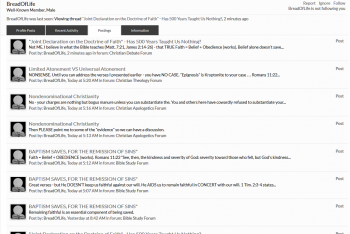FHII
Well-Known Member
- Apr 9, 2011
- 4,833
- 2,500
- 113
- Faith
- Christian
- Country
- United States
So you are not going to answer any of my questions?Alexander Hislop’s “The Two Babylons” piece of shoddy history and angry opinions.
Let’s start with Wikipedia’s review . . .
The book has been severely criticized for its lack of evidence, and in many cases its contradiction of the existing evidence: for instance, the Roman state religion before Christianity did not worship a central Mother Goddess, and Jupiter was never called "Jupiter-Puer."
Likewise, Semiramis lived centuries after Nimrod, and could neither have been his mother, nor married him. Hislop also makes unacceptable linguistic connections and fanciful word plays, e.g. the letters IHS on Catholic Holy Communion wafers are alleged to stand for Egyptian deities Isis, Horus and Seth, but in reality they are an abbreviation for Ihsous, the Latin spelling of Jesus's name in Greek (Ιησους), although popularly, they stand for the Latin Iesus Hominum Salvator meaning Jesus, Savior of Mankind (which also fits the teaching of Transubstantiation, where the wafer and wine are said to become the body and blood of Christ).” (Source: Wikipedia article, Alexander Hislop. Alexander Hislop - Wikipedia)
Regarding the etymology of “Easter” from the SAME Wikipedia page - in contrast with Hislop’s version:
The claim that Easter is derived from Ishtar has been questioned.[11] Modern etymologists derive the word Easter from the Proto-Indo-European root *aus-, meaning "dawn,"[12] potentially by way of *h₂ewsṓs.[13] Ishtar is a Semitic name of uncertain etymology, possibly taken from the same root as Assyria, or from a semitic word meaning "to irrigate."[14]
From Conservapedia:
https://www.conservapedia.com/%27%27The_Two_Babylons%27%27
The work has been completely discredited by painstaking professional historical research, and thoroughly rebutted and refuted by strongly evangelical former supporters who did follow-up research of their own.
Historians who have carefully researched the historical claims made in this book, and the source materials that author Hislop relied on, have determined that he is unreliable as an historian. Almost all of his "facts" are shown to be false, and his reasoning from superficial similarities of appearances and ritual actions is demonstrated to be completely unsound and without merit as "proofs" of pagan origins. This has demolished his credibility. 16th–19th century anthropologists who were contemporaries of the authors of his source materials have also shown that even among historians in the 16th–19th centuries most of his sources had no reliable historical credibility as researchers.
Impartial and objective evaluations by non-Catholic reviewers of this book have also determined that it is simply a calumny against the Catholic religion. This has refuted his Christian integrity as a writer. This does not prove that Alexander Hislop was a liar, but only that his book is full of falsehoods. There is a difference. He may indeed have been sincere in his belief. His methology was entirely wrong. His conclusions are errors.
From the Christian Research Institute:
https://www.equip.org/article/the-two-babylons/
The subtitle for Hislop’s book is “The Papal Worship Proved to Be the Worship of Nimrod and His Wife.” Yet when I went to reference works such as the Encyclopedia Britannica, The Americana, The Jewish Encyclopedia, The Catholic Encyclopedia, The Worldbook Encyclopedia – carefully reading their articles on “Nimrod” and “Semiramis” — not one said anything about Nimrod and Semiramis being husband and wife. They did not even live in the same century. Nor is there any basis for Semiramis being the mother of Tammuz. I realized these ideas were all Hislop’s inventions.
The fact that you don’t believe Ralph Woodrow is YOUR problem. He was FAR more familiar with Hislop’s work that YOU. – and the weight of scholarship is on HIS side . . .


